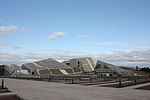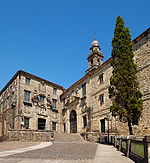Library of Galicia
2011 establishments in SpainLibraries established in 2011Libraries in SpainLibrary building and structure stubsSpanish building and structure stubs

The Library of Galicia (Galician: Biblioteca de Galicia), is a Spain-based public library located in the Galician Cultural City of Santiago de Compostela, the capital of the Galicia Autonomous Region, Spain. It is the largest public library in the Galicia Autonomous Region. The library was designed by American architect Peter Eisenman. Library of Galicia disseminates the legacy of intellectuals and artists such as Isaac Díaz Pardo, Luis Seoane and Basilio Losada. The library is the flagship of Galician library system.
Excerpt from the Wikipedia article Library of Galicia (License: CC BY-SA 3.0, Authors, Images).Library of Galicia
Avenida de Manuel Fraga Iribarne, Santiago de Compostela
Geographical coordinates (GPS) Address Nearby Places Show on map
Geographical coordinates (GPS)
| Latitude | Longitude |
|---|---|
| N 42.8698 ° | E -8.5262 ° |
Address
Xardín do Teatro
Avenida de Manuel Fraga Iribarne
15703 Santiago de Compostela
Galicia, Spain
Open on Google Maps









